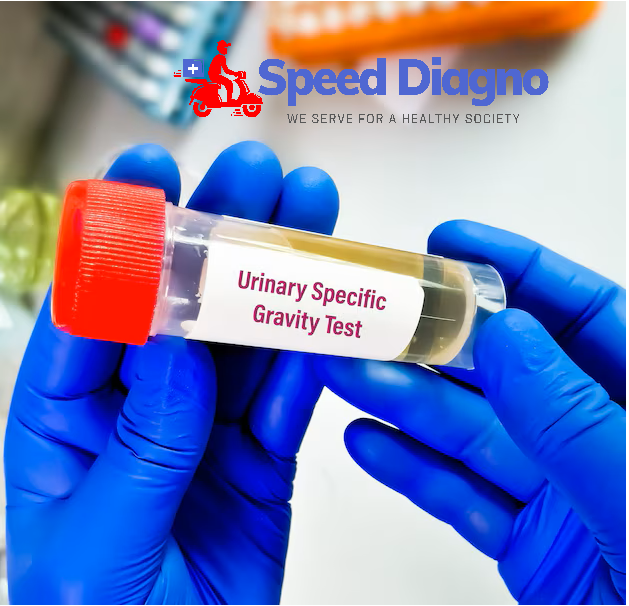- Home
-
Test Categories
- Diabetes
- Urinary
- Thyroid
- RTPCR
- Genetic
- Cancer
- Haematology
- Biochemistry
- Serology & Immunology
- Clinical Pathology
- Cytology
- Microbiology
- Endocrinology
- Histopathology
- MOLECULAR DIAGNOSTICS
- Pregnancy(Biochemistry)
- Liver
- Prostate
- Fertility
- Gastro
- Autoimmune Disorders
- Heart
- Kidney
- Vitamins
- Tuberculosis (TB)
- Anemia
- Fever
- Allergy
- Blood Tests Rare
- Profiles
- Packages
- About Us
- Why Choose Us
- Upload Prescription
- Corporate Wellness
- Contact Us

-
Overview
Specific Gravity (SG) Test measures the concentration of solutes (such as salts, waste products, and other substances) in urine. It helps assess the kidney’s ability to concentrate urine and can indicate conditions like dehydration, kidney disorders, urinary tract infections, and other metabolic conditions. The test compares the density of urine to the density of water, providing insights into how well the kidneys are maintaining fluid and electrolyte balance.
Patient Preparation for Specific Gravity Test
Fasting Requirements:
- Fasting: No fasting is required for this test. The patient can eat and drink normally unless instructed otherwise by the healthcare provider.
Other Preparations:
- Hydration Status: It is important to maintain normal hydration before the test. Excessive fluid intake or dehydration can skew the results.
- Avoid Certain Medications and Substances: Some medications, vitamins, or dyes used in medical tests can affect specific gravity readings. Inform your healthcare provider about any substances you are taking.
Sample Collection Process by Speediagno Phlebotomist or Technician:
Speediagno follows proper protocols to ensure a clean and accurate sample collection for the specific gravity test.
Preparation for Sample Collection:
- Identify the Patient: The technician confirms the patient’s identity using at least two identifiers (e.g., name and date of birth).
- Consent and Explanation: The procedure is explained to the patient, ensuring they understand how to collect the urine sample correctly.
Urine Collection Process:
- Collection Kit: The patient is provided with a sterile urine collection container and instructed on how to collect the sample.
- Midstream Collection Technique:
- Clean the Area: The patient should clean the genital area with a provided antiseptic wipe to minimize contamination from external bacteria.
- Start and Stop: Begin urinating into the toilet, pause briefly, then collect the midstream portion of urine into the sterile container, filling it about halfway. Avoid touching the inside of the container or its lid.
- Finish in the Toilet: Once the sample is collected, the rest of the urine can be voided into the toilet.
Post-Collection Care:
- Sealing and Labeling: The container is sealed tightly and labeled with the patient’s details, including the date and time of collection.
- Transport: The urine sample should be delivered to the laboratory promptly, ideally within an hour, to ensure accurate test results.
Safety and Hygiene Protocols:
- Proper Disposal: Any used wipes, gloves, or other disposable items should be disposed of in designated biohazard containers.
- Hand Hygiene: Hands should be washed thoroughly after collecting and handling the urine sample.
Laboratory Processing:
- Measurement of Specific Gravity: The specific gravity is measured using a refractometer or a dipstick:
- Refractometer: This instrument measures how light bends (refracts) as it passes through the urine sample, giving a precise SG reading.
- Dipstick: A reagent strip is dipped into the urine, and the color change is compared to a chart to estimate specific gravity.
- Normal Values: Specific gravity typically ranges from 1.005 to 1.030. Higher values indicate concentrated urine (potential dehydration), while lower values suggest dilute urine (overhydration or kidney issues).
- Measurement of Specific Gravity: The specific gravity is measured using a refractometer or a dipstick:
This careful approach ensures that the specific gravity test results accurately reflect the patient’s hydration status and kidney function, providing valuable information for diagnosis and treatment planning.
All test groups and subgroup
-
SPECIFIC GRAVITY
-
Urine For Specific Gravity Specific Gravity
-
